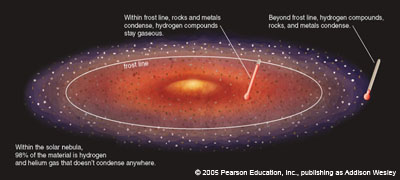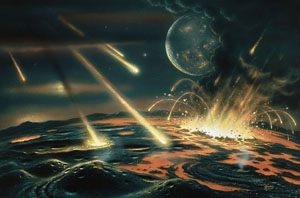The Law of Gravity Says that Everything Attracts Everything Else
Gravity is the attractive force between objects that have mass. In space, this means that a swarm of small objects eventually collects into a big one under the influence of gravity. This is how moons, planets, and stars form.
The gravitational attraction exerted by a more-massive object on a less-massive one can have different outcomes, depending on their relative motion:
- The smaller object can crash into the bigger one.
- The smaller object can be deflected away.
- If conditions are just right, the smaller object can be pulled into orbit around the bigger one.
 What is Gravity Anyway?
What is Gravity Anyway?
Isaac Newton (1643-1727) was the first to realize that the force that makes things fall toward Earth also operates on the distant Moon, keeping it in its orbit around our planet. This force, called gravity, is a property of all matter. Newton’s universal law of gravitation describes the way gravity varies with mass (the amount of matter) and distance.

Albert Einstein (1879-1955) went further to conclude that gravity is intimately connected to space and time. Space is curved by the presence of matter, which is why moons, planets, and other objects follow curved paths.

The Solar System formed when a huge cloud of gas and dust slowly collapsed under the influence of gravity. The tremendous heat and pressure at the center of this collapsing cloud ignited nuclear reactions in the sphere of gases that became the Sun.
Meanwhile, leftover material surrounding the Sun collected into planets. Near the Sun, a solar “wind” of charged particles drove away the gas and ice, leaving rocks and dust. This material formed into the rocky planets, including Earth. Farther from the Sun, gas and ice became the major ingredients of the four giant planets: Jupiter, Saturn, Uranus, and Neptune.
 How Did the Giant Worlds Get So Big?
How Did the Giant Worlds Get So Big?
A "frost line" between the orbits of Mars and Jupiter determined the nature of the planets forming on either side of the line. Between the Sun and Mars, temperatures were too high for gaseous material to condense into ice chunks. But beyond Mars, temperatures were cold enough to allow ice to form and collect into large objects that became the cores of the giant worlds. Because there was so much of this material, these outer planets became giant.
Crash Course
The planets that we know today are the survivors of a violent era of collisions. Planetary bodies careened around the Solar System, crashing into each other until only the largest were left. It was not a good time to be on the infant Earth.
The largest planet, Jupiter, exerted a powerful gravitational influence. If Jupiter had formed closer to the Sun, Earth and some of the other inner planets might have been thrown out of the Solar System!
 Snowballs from Space
Snowballs from Space
Jupiter, Saturn, Uranus, and Neptune formed amid a blizzard of ice particles. They swept up much of this frozen material. But much also collected into huge “iceballs.” The powerful gravity of the giant worlds flung most of the iceballs into the outskirts of the Solar System.
However, some were diverted toward Earth, where they crashed and deposited vast amounts of water – maybe enough to fill our oceans. Since life probably started in the oceans, we may owe our existence to these snowballs from afar.
Activities
Birth of Our Solar System (animation)
Crash Course (animation)
Friend or Foe



